Izabal is a beautiful region in Guatemala that is home to various birds. With its tropical forests, mangroves, lagoons, and wetlands, Izabal is a paradise for birdwatchers.
The region is home to over 500 species of birds, including toucans, parrots, hummingbirds, cormorants, kingfishers, and many more. Birdwatching in Izabal is a fantastic experience for anyone interested in discovering the region’s incredible biodiversity.
Izabal is an excellent destination for bird enthusiasts, from colorful parrots to majestic eagles.
21 Birds to Watch in Izabal
Izabal is a beautiful region in Guatemala that is home to various birds. With its tropical forests, mangroves, lagoons, and wetlands, Izabal is a paradise for birdwatchers.
The region is home to over 500 species of birds, including toucans, parrots, hummingbirds, cormorants, kingfishers, and many more.
Here are 21 birds that you can watch in Izabal.
1. Pied-billed Grebe
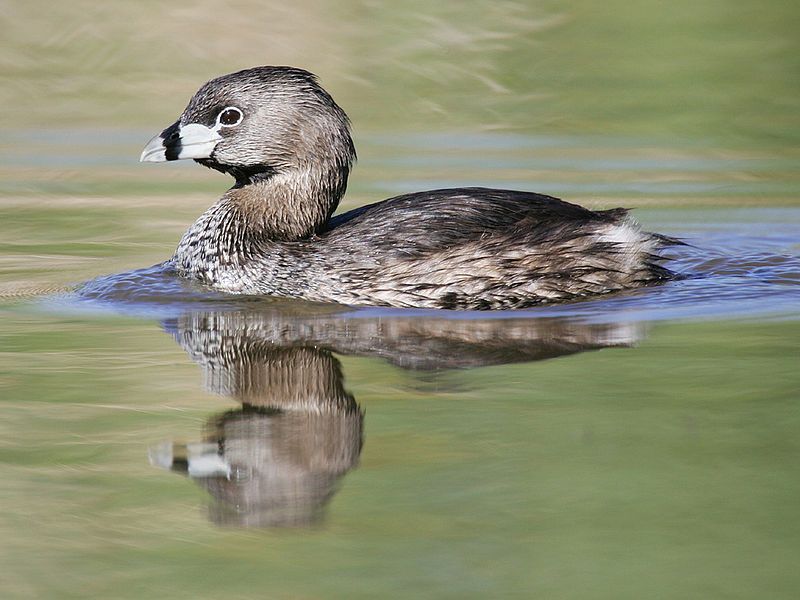
The Pied-billed Grebe is a water bird belonging to the Grebe family. It is the only species remaining in the genus Podilymbus following the extinction of the Atitlán grebe. This species is native to the Americas and is often found in ponds located in the region.
This species has a distinctive black bill on top and white in the center, thus giving it its name. The Pied-Billed Grebe has an olive-brown back and white underparts. It has a short neck and a rounded head.
It is a relatively small bird with a body length of 11-14 inches. This species is an excellent swimmer and diver. It uses its feet to propel itself in the water and its wings to maneuver in tight spaces. Its diet consists mainly of aquatic insects, small fish, and crustaceans.
It is also known to eat some plant material. The Pied-billed Grebe is an essential species in the Americas, as it helps to maintain the balance of aquatic ecosystems.
| Kingdom | Animalia |
| Phylum | Chordata |
| Class | Aves |
| Order | Podicipediformes |
| Family | Podicipedidae |
| Genus | Podilymbus |
| Species | P. podiceps |
2. Great Tinamou
The great tinamou is a species of bird that belongs to the tinamou family and is native to Central and South America. This ground-dwelling bird is characterized by its long legs and large feet, which allow it to move quickly over the ground.
It has a long and slender bill, and its plumage combines browns, grays, and black. The great tinamou has several subspecies, with the most notable difference being their coloration.
For example, the red-legged tinamou has a reddish-brown body with lighter wings and tail, while the black-legged tinamou has a black body with white underparts. Other subspecies have a combination of colors, including various shades of brown, gray, and black.
In addition to coloration, other differences between the subspecies include size, habitat, and diet.
| Kingdom | Animalia |
| Phylum | Chordata |
| Class | Aves |
| Order | Tinamiformes |
| Family | Tinamidae |
| Genus | Tinamus |
| Species | T. major |
3. Common Pauraque
The pauraque, also known as the common pauraque, is a species of nightjar bird. It is one of two birds that belong to the genus Nyctidromus. This species is native to the subtropical and tropical regions of the New World.
The pauraque is mostly a non-migratory bird, except the northernmost birds that migrate to warmer climates during the winter. This species is found in many habitats, from open grasslands to semi-arid woodlands.
They are nocturnal and feed mainly on insects, which they hunt by swooping down from the air. The pauraque has a distinctive plumage with a mottled brown and white pattern. The males have a white throat patch, while the females have an orange one.
They have long, pointed wings and a long tail, which helps them maneuver in the air as they hunt their prey.
| Kingdom | Animalia |
| Phylum | Chordata |
| Class | Aves |
| Clade | Strisores |
| Order | Caprimulgiformes |
| Family | Caprimulgidae |
| Genus | Nyctidromus |
| Species | N. albicollis |
4. Pale-vented Pigeon
The pale-vented pigeon is a large pigeon found in the tropical Americas. It is a member of the genus Patagioenas, a bird group that has evolved over many years to inhabit a wide range of warm-temperate and tropical habitats.
This evolutionary radiation has enabled the pale-vented pigeon to become one of the most widespread species of its family, inhabiting much of Central and South America. The pale-vented pigeon is a medium-sized bird with a length of around 11 inches and a wingspan of up to 24 inches.
Its plumage is predominantly gray, with a distinctive white band across its vent. Its head and neck are black, and its tail is tipped with a white band.
The pale-vented pigeon has a broad diet, feeding on fruits, seeds, nuts, and invertebrates. The pale-vented pigeon is a social bird, often living in flocks of up to 15 individuals. They are known to be quite vocal and can usually be heard in the early morning and late evening.
They are monogamous birds, and the two partners often remain together for life. Overall, the pale-vented pigeon is an impressive bird species, having evolved over many generations to inhabit a wide range of warm-temperate and tropical Americas.
Its impressive evolutionary radiation has allowed it to become one of the most widespread species of its family, and it is a true marvel of the natural world.
| Kingdom | Animalia |
| Phylum | Chordata |
| Class | Aves |
| Order | Columbiformes |
| Family | Columbidae |
| Genus | Patagioenas |
| Species | P. cayennensis |
5. Plain Chachalaca
The plain chachalaca is an impressive species of bird belonging to the Cracidae family, which includes chachalacas, guans, and curassows.
It is native to a wide range of tropical and subtropical habitats, stretching from the Rio Grande Valley in the southernmost United States to Costa Rica in the northernmost region.
The plain chachalaca typically inhabits mesquite thickets, dense, woody shrubs, and small trees in dry habitats.
This species is quite large and is known for its distinctive vocalizations and loud, raucous calls that can often be heard in the early morning.
| Kingdom | Animalia |
| Phylum | Chordata |
| Class | Aves |
| Order | Galliformes |
| Family | Cracidae |
| Genus | Ortalis |
| Species | O. vetula |
6. Scaly-breasted Hummingbird
The scaly-breasted hummingbird or scaly-breasted brewing is a species of hummingbird that is part of the “emeralds,” a tribe of subfamily Trochilinae.
This species of hummingbird is found in various countries in Central and South America, including Belize, Colombia, Costa Rica, Guatemala, Honduras, Mexico, Nicaragua, and Panama.
These tiny birds are renowned for their vibrant colors and distinctive markings, including iridescent green feathers, white patches, and dark scales on the chest. As hummingbirds, they are also capable of hovering and flying backward and forwards with great agility.
This hummingbird species is found in various habitats, ranging from humid rainforests to dry scrublands. They feed on the nectar of flowers and small insects and spiders. In addition, they have also been known to feed on tree sap.
This hummingbird species is a famous sight for birdwatchers as it is relatively easy to spot in its native range.
| Kingdom | Animalia |
| Phylum | Chordata |
| Class | Aves |
| Clade | Strisores |
| Order | Apodiformes |
| Family | Trochilidae |
| Genus | Phaeochroa |
| Species | P. cuvierii |
7. Rufous-tailed Hummingbird
The Rufous-tailed Hummingbird is a species of hummingbird that belongs to the Trochilini tribe of the Trochilinae subfamily. It is in east-central Mexico, Central America, Colombia, Ecuador, and Venezuela. This species is considered to be of medium size.
The Rufous-tailed Hummingbird is a brightly colored bird with a white chin, a green throat, and a rufous-colored tail. The wings are green, and the belly is grayish. The tail is long and curved, and the bill is slightly down-curved.
Its call is a high-pitched chirp, an active forager, often seen hovering while feeding on nectar and small insects. The Rufous-tailed Hummingbird is a solitary species not usually seen in large flocks.
It is migratory, breeding in northern Mexico and the southern United States and migrating south for the winter. It prefers montane and forest habitats but can also be seen in gardens and other urban areas.
This species is threatened by habitat loss due to deforestation, agricultural practices, and urbanization. Therefore, it is essential to conserve the habitats that this species depends on for survival.
| Kingdom | Animalia |
| Phylum | Chordata |
| Class | Aves |
| Clade | Strisores |
| Order | Apodiformes |
| Family | Trochilidae |
| Genus | Amazilia |
| Species | A. tzacatl |
8. Great Egret
The great egret is a large, widely distributed bird in many parts of the world. It is also known as the common egret, large egret, great white egret, or great white heron.
The great egret has four subspecies, which can be found in Asia, Africa, the Americas, and southern Europe. In more recent years, it has also been spotted in more northern areas of Europe, indicating that its range is expanding.
The great egret is a majestic bird with white plumage and yellow bill. Its wingspan is around 40-50 inches, and it is pretty tall when standing, with a height of up to four feet. It has long legs and a long neck, often held in an S-shape.
It is an opportunistic feeder whose diet consists mainly of small fish, amphibians, reptiles, and insects. The great egret is a protected species in many countries, and its population is increasing due to the conservation efforts of many organizations.
It is considered a symbol of grace and beauty and has been a part of many cultures throughout history. Its presence reminds us of the importance of protecting our natural world and its inhabitants.
| Kingdom | Animalia |
| Phylum | Chordata |
| Class | Aves |
| Order | Pelecaniformes |
| Family | Ardeidae |
| Genus | Ardea |
| Species | A. alba |
9. Snowy Egret
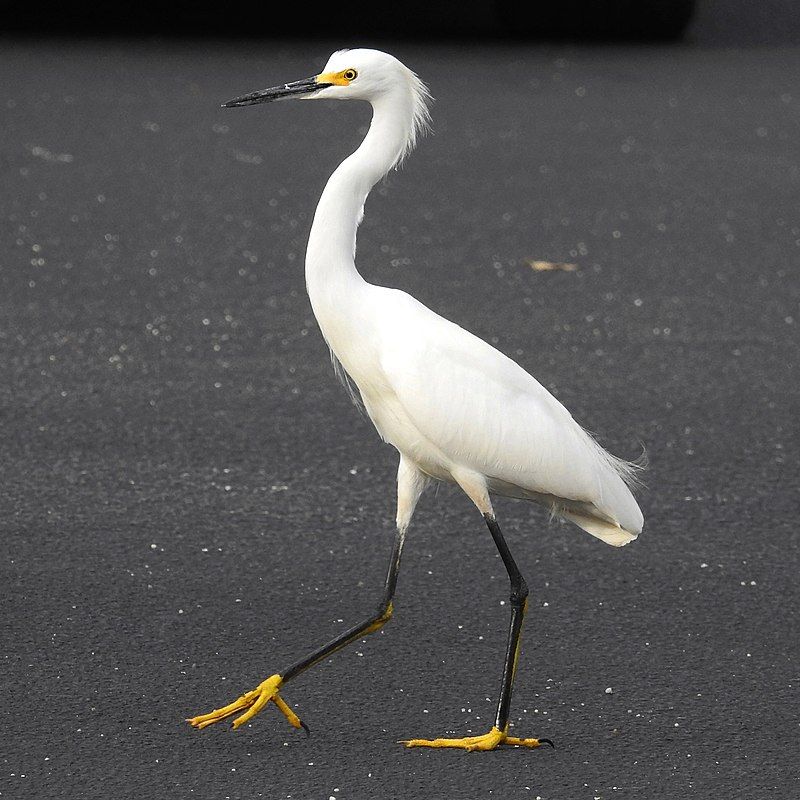
The snowy egret is a small white heron native to North, Central, and South America. It is a member of the heron family, and its genus name is derived from Provençal French for the little egret, aigrette.
The species name, thula, is an Araucano term for the black-necked swan. This name was applied to the snowy egret in error by Chilean naturalist Juan Ignacio Molina in 1782. The snowy egret is a beautiful white bird with a long, slender neck and long legs.
It has a black bill and yellow feet. Its wings are white with black tips. During breeding season, the snowy egret has long, lacy plumes on its back and head, giving it a distinct appearance. The snowy egret feeds mainly on fish, frogs, and crustaceans.
It can also be found foraging in shallow waters for food. It is usually seen wading in shallow waters, standing still, and waiting for prey to come close. The snowy egret is a social bird often seen in flocks.
They usually nest in small colonies in trees or shrubs near bodies of water. They lay two to four eggs and incubate them for about three weeks.
Both the male and female help in caring for the young. The snowy egret is an important species of bird that provides valuable ecosystem services. They remove unwanted insects from wetlands, and they also help to control the spread of disease-causing organisms.
They also provide a valuable source of food for other animals. The snowy egret is an important species to protect and should be conserved for future generations.
| Kingdom | Animalia |
| Phylum | Chordata |
| Class | Aves |
| Order | Pelecaniformes |
| Family | Ardeidae |
| Genus | Egretta |
| Species | E. thula |
10. Ardeidae
Herons are a large family of birds that can be found near freshwater and coastal areas all over the world. They are part of the Ardeidae family and are currently 72 recognized species.
Some species are known as egrets or bitterns, but they are still classified as herons. Herons are distinguished by their long legs and long necks.
They are usually tall and slender birds, generally gray or blue, with some species having white or black plumage. They are carnivorous birds and mainly eat small fish, amphibians, and other aquatic creatures.
Herons are also known for their graceful and slow flight, as they often soar high above the water and slowly flap their wings to stay in the air. They are also excellent swimmers, with webbed feet that help them quickly move through the water.
Herons are essential to many ecosystems, as they help control populations of insects and other aquatic animals and provide food for predators like owls and hawks.
They are also important to humans, as they are often used as food, and their feathers are used to adorn clothing.
| Kingdom | Animalia |
| Phylum | Chordata |
| Class | Aves |
| Order | Pelecaniformes |
| Family | Ardeidae |
11. Black-bellied Whistling Duck
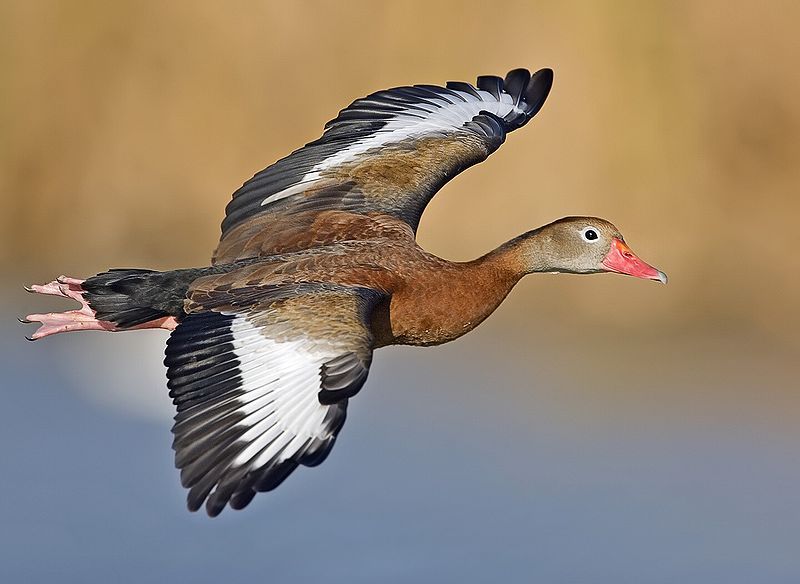
The black-bellied whistling duck, previously known as the black-bellied tree duck, is a species of whistling duck. This duck species was mainly found in the southernmost areas of the United States, Mexico, and tropical Central to south-central South America before 2000.
The black-bellied whistling duck is found year-round in many parts of the United States. This duck species can be easily identified by its unique coloration. The upper parts of the duck are mottled brown, while its underside is black and white.
In addition to its distinct coloration, this duck species is also known for its whistling call. The ducks often use their whistles to form pairs and locate each other in the wild. The black-bellied whistling duck is a very adaptable species.
Its diet includes various foods, such as seeds, grains, insects, and aquatic plant material.
This duck species is also exceptionally social; they often form large flocks that can be seen foraging in swamps, marshes, and wetlands. The black-bellied whistling duck is unique in many parts of the United States.
It is easily recognized by its distinct coloration and the whistling call it produces. This species is adaptable and can be found in various habitats, often forming large flocks to feed on different foods.
| Kingdom | Animalia |
| Phylum | Chordata |
| Class | Aves |
| Order | Anseriformes |
| Family | Anatidae |
| Genus | Dendrocygna |
| Species | D. autumnalis |
12. White-necked Jacobin
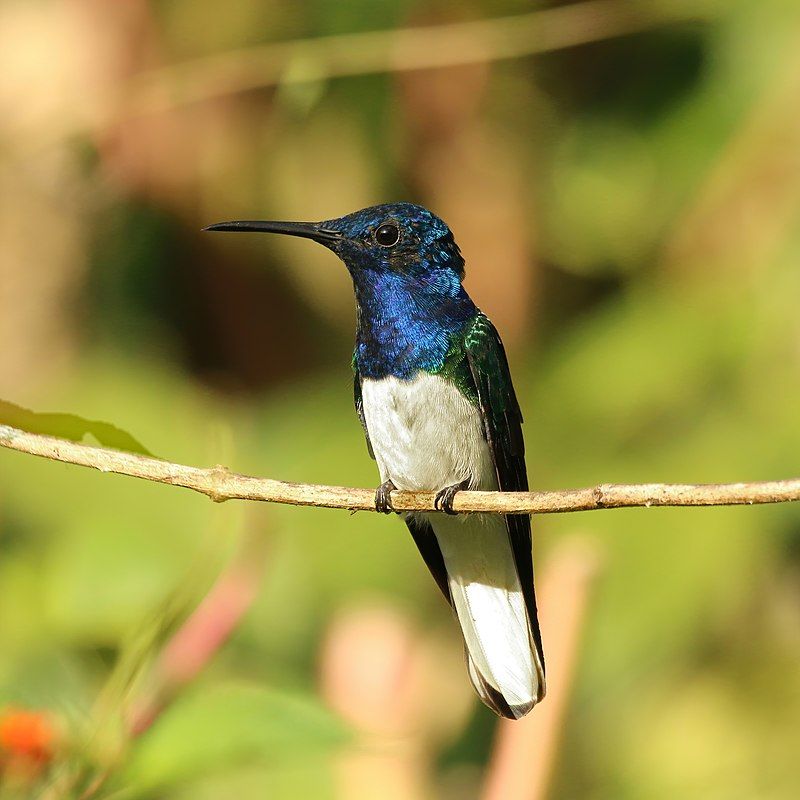
The white-necked jacobin is a species of hummingbird found in a wide range of places, from Mexico down to Brazil, Peru, Bolivia, and even Trinidad & Tobago. It is a medium-sized bird weighing about 5 inches and weighing approximately 6.5 grams.
It is mainly a solitary bird, but it can be seen in pairs or small groups during breeding season. The white-necked jacobin has a distinct white throat, dark head, grayish-green back, and yellow belly.
The male has a blue crest and a black chin, while the female has a brown crest and a white chin. The wings have a dark trailing edge and a white stripe near the body—the white-necked jacobin feeds on nectar from flowering plants, small insects, and spiders.
It has a fast and direct flight, often hovering in the air as it feeds. It prefers forests and open woodlands but can also be found in gardens and parks. The white-necked jacobin is also known by several other names, including great jacobin and collared hummingbird.
It is a relatively common bird, but its population is declining in some areas due to habitat destruction. Conservation efforts are needed to ensure its continued survival.
| Kingdom | Animalia |
| Phylum | Chordata |
| Class | Aves |
| Clade | Strisores |
| Order | Apodiformes |
| Family | Trochilidae |
| Genus | Florisuga |
| Species | F. mellivora |
13. Bare-throated Tiger Heron
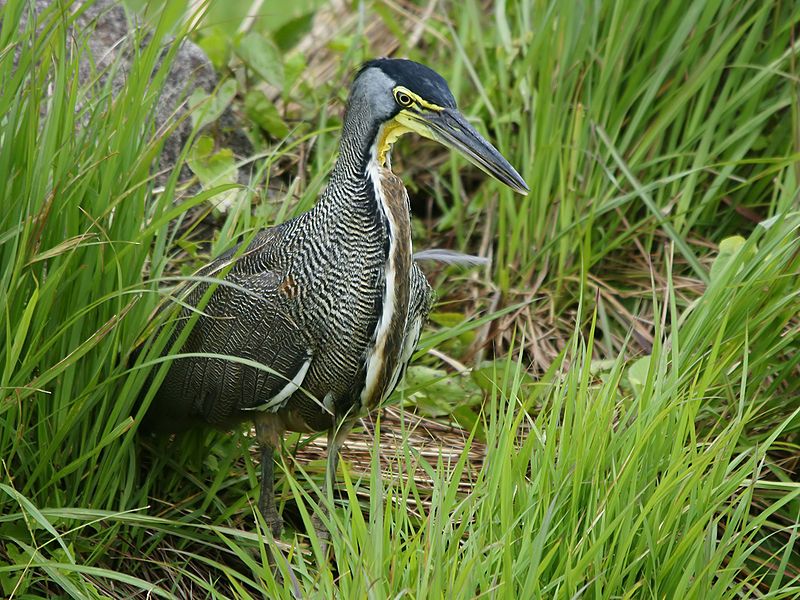
The bare-throated tiger heron is a spectacular wading bird of the heron family, Ardeidae. It has an extensive range, being found from Mexico to northwestern Colombia.
Interestingly, there was one recorded sighting of this species in the United States, in Hidalgo County, Texas. This species has an impressive size, measuring 80 cm in length and weighing 1,200 g.
It is a long-legged, mostly grey birdy, with a black head and neck and white stripes on the side of its neck. It has bright yellow eyes and a large, slightly curved bill.
This species is usually seen hunting in shallow water or along the shoreline, where it preys on fish, amphibians, insects, and other small creatures. It is an opportunistic feeder that will also utilize available food sources.
The bare-throated tiger heron is a fascinating species that will captivate anyone lucky enough to observe it in its natural habitat.
| Kingdom | Animalia |
| Phylum | Chordata |
| Class | Aves |
| Order | Pelecaniformes |
| Family | Ardeidae |
| Genus | Tigrisoma |
| Species | T. mexicanum |
14. Spotted Wood-Quail
The spotted wood quail is a small New World quail family bird. These birds are found in the mountainous regions of Central America, ranging from southern Mexico to western Panama.
They live in habitats at least 1000 meters above sea level and usually inhabit thickets or bamboo in dense understory vegetation. The spotted wood quail is a resident breeder, which means they can reproduce in the same area where they reside.
They can live in the highlands up to the timberline, where trees no longer grow due to the cold or extreme weather.
The spotted wood quail is an integral part of the Central American ecosystem, as they play a role in the food chain and help ensure the balance of the environment.
| Kingdom | Animalia |
| Phylum | Chordata |
| Class | Aves |
| Order | Galliformes |
| Family | Odontophoridae |
| Genus | Odontophorus |
| Species | O. guttatus |
15. White-collared Swift
The white-collared swift is a species of bird from the family Apodidae, which includes swifts and treewifts. This species is part of the subfamily Cypseloidinae, which contains the swifts found in the Americas and some species in Africa, Asia, and Europe.
The white-collared swift is native to Mexico, the Greater and Lesser Antilles, Trinidad, and all mainland South American countries except Uruguay. It is a small bird with a long, pointed wingspan and a white collar on its chest.
Its diet consists mainly of insects, which it captures on the wing. During the breeding season, the white-collared swift builds a cup-shaped nest out of mud and straw, which attaches to vertical surfaces. It lays two to three eggs, which both parents incubate.
After hatching, the young birds are fed by both parents until they are ready to fledge. The white-collared swift is an adaptable species, and it has been recorded in various habitats, including urban gardens, farms, and even deserts.
| Kingdom | Animalia |
| Phylum | Chordata |
| Class | Aves |
| Clade | Strisores |
| Order | Apodiformes |
| Family | Apodidae |
| Genus | Streptoprocne |
| Species | S. zonaris |
16. Gray-chested Dove
The Grey-chested Dove is a species of bird found in Central and South America. It belongs to the Columbidae family, also known as the “pigeon and dove” family.
This species is found in several countries, including Belize, Colombia, Costa Rica, Guatemala, Honduras, Mexico, Nicaragua, and Panama. The Grey-chested Dove is a medium-sized bird with a grey chest, white head, and brown back.
Its wings are brown with black edges, and its tail is white with a black tip. It has a grey bill and brown eyes. The Grey-chested Dove feeds on seeds, fruits, and other small invertebrates in its natural habitat.
It can be found in various habitats, such as woodland, savanna, and dry shrubland. It prefers to nest in trees or shrubs near rivers and streams.
The Grey-chested Dove breeds during the dry season and typically lays two white eggs. The Grey-chested Dove is not currently considered threatened, but its population is declining due to habitat destruction and fragmentation.
It is also hunted for food in some parts of its range. Conservation efforts are needed to ensure the long-term survival of this species.
| Kingdom | Animalia |
| Phylum | Chordata |
| Class | Aves |
| Order | Columbiformes |
| Family | Columbidae |
| Genus | Leptotila |
| Species | L. cassinii |
17. Gray-headed Dove
The grey-headed dove is a large species of dove that is found in the New World. It is native to eastern Mexico and can be found down to Colombia. It is a relatively large bird, measuring around 12 inches long, and its body is predominantly grey.
Its head is a light shade of grey, and it has a distinct black spot near its eyes.
The bill is also black, and the wings are tipped with white. The grey-headed dove is a very adaptable species, and it can be found in various habitats, from dense forests to open grasslands.
It is usually found in pairs or small flocks and feeds mainly on seeds and fruits. It nests in trees or shrubs and lays one to two eggs. The grey-headed dove is not currently considered threatened or endangered. However, it is still vulnerable to habitat loss and hunting.
It symbolizes peace and tranquility, and its distinctive call is often heard in the early morning.
| Kingdom | Animalia |
| Phylum | Chordata |
| Class | Aves |
| Order | Columbiformes |
| Family | Columbidae |
| Genus | Leptotila |
| Species | L. plumbeiceps |
18. Green-breasted Mango
The green-breasted mango, also known as Prevost’s mango, is a hummingbird belonging to the subfamily Polytminae in the Trochilidae family.
This species can be found in various places, including eastern Mexico, Central America, Colombia, and Venezuela, and even as a rare visitor in the United States.
This hummingbird species is known for its unique green breast, distinguishing it from other hummingbird species. It is also known for its long wingspan and impressive flying ability.
Its diet consists mainly of nectar from flowers and small insects, and it is often seen hovering around flowers. Its beautiful plumage makes it a famous sighting among birdwatchers.
| Kingdom | Animalia |
| Phylum | Chordata |
| Class | Aves |
| Clade | Strisores |
| Order | Apodiformes |
| Family | Trochilidae |
| Genus | Anthracothorax |
| Species | A. prevostii |
19. Little Tinamou
The little tinamou is a small bird species belonging to the genus Tinamus. It is native to Central and South America, as well as to the Caribbean island of Trinidad. This species is found mainly in lowland rainforests and has a wide range from Mexico to northern Argentina.
A ground-dwelling bird prefers to feed on seeds, fruits, and insects. It is typically found in pairs or small groups and is usually shy and secretive. The little tinamou is a medium-sized bird with a long tail and a short bill.
It is grey-brown with a white belly and a white stripe on the forehead. These birds have strong legs and can fly short distances. The little tinamou is an integral part of the ecosystem, as it helps to disperse seeds and feed on small insects.
It is also an important food source for many predators, such as hawks, harpy eagles, and snakes.
| Kingdom | Animalia |
| Phylum | Chordata |
| Class | Aves |
| Order | Tinamiformes |
| Family | Tinamidae |
| Genus | Crypturellus |
| Species | C. soui |
20. White-bellied Emerald
The white-bellied emerald is a species of hummingbird belonging to the Trochilini tribe of the Trochilinae subfamily. This hummingbird species is found in several Central American countries, including Belize, Guatemala, Honduras, Panama, Mexico, and Nicaragua.
The white-bellied emerald is easily distinguishable due to its bright emerald-green coloration. This hummingbird’s wings are typically greenish-black in color, while its underbelly is a bright white.
The white-bellied emerald is also known for its long beak, which allows it to reach deep into flowers for nectar.
The white-bellied emerald is a significant species to many of the ecosystems in Central America, as it helps to pollinate flowers and provide food for other animals that inhabit the region.
It is essential to ensure the safety of this species, as it is a vital part of the Central American ecosystem.
| Kingdom | Animalia |
| Phylum | Chordata |
| Class | Aves |
| Clade | Strisores |
| Order | Apodiformes |
| Family | Trochilidae |
| Genus | Chlorestes |
| Species | C. candida |
21. Sora
The sora is a small waterbird that belongs to the Rallidae family, commonly called the sora rail or sora crake. This species of bird can be found in many parts of North America. The genus name Porzana is an Italian term used to describe small rails.
The name Carolina is derived from the Carolina Colony, an area of North America that the British initially colonized. The sora is a unique bird easily recognizable due to its distinctive plumage and call.
It is a shy species that prefers to remain in dense vegetation or marshes and is known to forage in shallow waters. The sora is an important species to the ecology of many parts of North America, as it helps keep the insect and aquatic plant populations balanced.
| Kingdom | Animalia |
| Phylum | Chordata |
| Class | Aves |
| Order | Gruiformes |
| Family | Rallidae |
| Genus | Porzana |
| Species | P. carolina |
Conclusion
The birds of Izabal are a wonderful and diverse collection of species. They are essential for the local ecosystems and provide a great source of beauty and enjoyment to the region.
The variety of species, habitats, and activities make it a great place to visit and observe birds in their natural environment.
As the region continues to develop, it is essential to ensure that bird populations and habitats remain healthy and abundant.